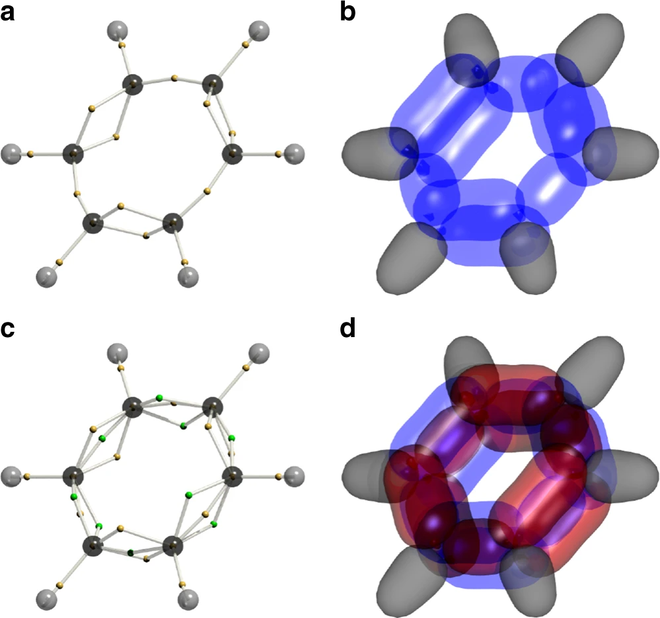Constructing the electronic structure of benzene, a compound with electrons that exists in 126 different directions

In 1825, Michael Faraday discovered the existence of benzene when condensation of glowing gases. For a long time, we have understood the atomic structure of benzene, but since the 1930s, science has been arguing about the electronic structure of benzene. If you don't already know, in quantum chemistry, 'electronic structure' is the movement state of electrons in an electrostatic field created by many fixed nuclei.
Discovering the electronic structure of benzene, we will have the building blocks of the future of the development of optoelectronic materials.
The atomic structure of benzene is as follows: is a ring of 6 carbon atoms and 6 hydrogen atoms, linked together in pairs. But the fact that benzene has 42 electrons makes it difficult to study its electronic structure.
' The benzene function describing the electron shows that it has up to 126 dimensions, ' said chemist Timothy Schmidt. 'This means that this function has up to 126 coordinate values, 3 for each of the 42 electrons. The electrons do not work independently, so it can't be split into 42 three-dimensional functions .'
According to researcher Schmidt, the answer of computers is not easy to understand, so scientists have to find their own way to get the answer.

They had to use math to describe the electronic structure of benzene, and the formula needed to calculate all 126 dimensions to be calculated. It sounds complicated, and the nature of the problem is really tough; that's why science has been fighting for decades. Some even question whether the electrons in benzene really work to solve this difficult problem.
There are two ways of thinking: one side thinks that benzene works based on valence theory , with the normally operating electrons (localized electrons, operating in a certain range); the other party argued that benzene followed the satellite molecular theory , the electrons were indeterminate, beyond the framework and reached out to nearby atoms.
The conundrum is that both theories do not explain the electronic structure of benzene.
So a new explanation is needed, and the 'Voronoi Metropolis dynamic sampling' technique has given researchers a way out. By algorithms that describe the wave function of a multi-electron system, they solved a difficult problem.
The new algorithm splits the electron directions into Voronoi diagrams, with each frame showing one electron coordinates, allowing the research team to draw the wave function diagrams of the entire 126 dimensions. And then they discovered something strange, changing the way science thinks about benzene.

Example of Vonoroi diagram.
Research shows that electrons will 'avoid' each other when they have a chance, reducing the energy inside the molecule, thereby making the benzene structure more stable than before.
' Basically, this discovery links previous observations of the chemical properties of benzene, showing us that the two available models describing benzene can fit together ,' Professor Schmidt said. to speak.
' And now we also know how to observe electron correlation - that is, how the electrons avoid each other. This has always been overlooked, when previous calculations were only applied when the energy was changing, not taking into account the internal electrical activity . '
The new research is published in Nature.
Refer to ScienceAlert
You should read it
- 11 tips to solve Math simple but extremely interesting
- Learning chemistry will become very interesting with the Chemical Equation application
- How to use MathType to write math formulas
- Insert brackets in Word, Excel
- Math object in JavaScript
- How to learn Math on Coolmath4Kids for kids
- Effective mobile math solutions
- 3 apps to help kids learn Math for free on Windows 10
May be interested
- Stack data structure (Stack)
 a stack is an abstract data structure (abstract data type - adt for short), mostly used in almost every programming language. name the stack because it acts as a stack in real life, such as a deck of cards or a stack of disks ...
a stack is an abstract data structure (abstract data type - adt for short), mostly used in almost every programming language. name the stack because it acts as a stack in real life, such as a deck of cards or a stack of disks ... - Data structure in C / C ++
 struct in c / c ++ arrays in c / c ++ allow you to define several types of variables that can hold the values of several members of the same data type. but the structure is another type of data in the c / c ++ programming language, which allows you to combine other types of data.
struct in c / c ++ arrays in c / c ++ allow you to define several types of variables that can hold the values of several members of the same data type. but the structure is another type of data in the c / c ++ programming language, which allows you to combine other types of data. - The mystery behind the unique toy: 'Simpson goes to the bridge' is driving young people crazy
 no matter how boring, just plug the stick into the 'hole' of bart simpson's character simulation and light it, all the sadness will vanish.
no matter how boring, just plug the stick into the 'hole' of bart simpson's character simulation and light it, all the sadness will vanish. - Stealing, electronic money scams in 2019 may hit a record of $ 4.3 billion
 fraud, theft, and electronic money scams can cost mankind $ 4.3 billion in 2019.
fraud, theft, and electronic money scams can cost mankind $ 4.3 billion in 2019. - Structure (Struct) in C programming
 arrays in c allow you to define several types of variables that can hold the values of several components of the same type. but the structure is another type of data in the c programming language, which allows you to combine other types of data.
arrays in c allow you to define several types of variables that can hold the values of several components of the same type. but the structure is another type of data in the c programming language, which allows you to combine other types of data. - What is URL? Structure of the URL
 what exactly is a url, what is its structure and composition? this article will give you an overview of urls and its structure.
what exactly is a url, what is its structure and composition? this article will give you an overview of urls and its structure. - New achievement: TSP chip structure can run 1 million billion operations per second
 chips with the tsp structure of startup groq can perform up to 1 peta task per second, that is, 1,000,000,000,000,000 actions per second.
chips with the tsp structure of startup groq can perform up to 1 peta task per second, that is, 1,000,000,000,000,000 actions per second. - How to check if Email exists or not using command line
 if you are experiencing email not being sent successfully, here are some tools to help you check if the recipient email address exists.
if you are experiencing email not being sent successfully, here are some tools to help you check if the recipient email address exists. - Sperm and eggs will not be able to meet if this compound is encountered
 the chemical compound that extracts pristimerin triterpenoids and lupeol will prevent the production of progesterone hormone when sperm reaches the egg, causing the sperm's calcium channel (called catsper) to not work.
the chemical compound that extracts pristimerin triterpenoids and lupeol will prevent the production of progesterone hormone when sperm reaches the egg, causing the sperm's calcium channel (called catsper) to not work. - Eyes round with 13 displays showing the pinnacle of electronic players
 playing electronic bins is very difficult, you have to buy slots and if you don't play well, it only takes less than 5 minutes to get game over. some gamers can reach the upper class with this game. don't believe it, let's see the high-performance displays of the electronic boxers below.
playing electronic bins is very difficult, you have to buy slots and if you don't play well, it only takes less than 5 minutes to get game over. some gamers can reach the upper class with this game. don't believe it, let's see the high-performance displays of the electronic boxers below.










 Tesla's 'Roadrunner' secret project reveals: Mass production of large-capacity batteries for $ 100 per kWh
Tesla's 'Roadrunner' secret project reveals: Mass production of large-capacity batteries for $ 100 per kWh New research: SARS-CoV-2 virus from nature, not from laboratory
New research: SARS-CoV-2 virus from nature, not from laboratory New research: audible flowers and the flapping of bee wings make honey more sweet
New research: audible flowers and the flapping of bee wings make honey more sweet Leedsichthys: The 'vacuum cleaner' of the Jurassic Sea was once misunderstood as a dinosaur
Leedsichthys: The 'vacuum cleaner' of the Jurassic Sea was once misunderstood as a dinosaur Paleontologists discovered the fat on the body of the fish lizard 180 million years ago
Paleontologists discovered the fat on the body of the fish lizard 180 million years ago Alcoholic anti-virus like?
Alcoholic anti-virus like?